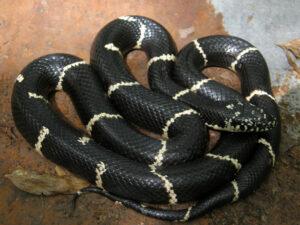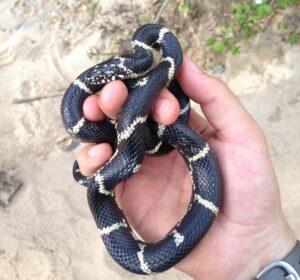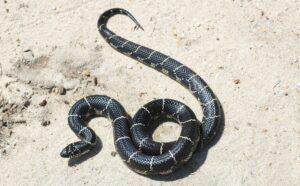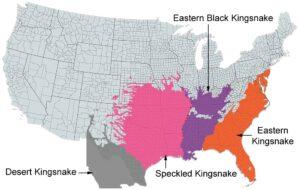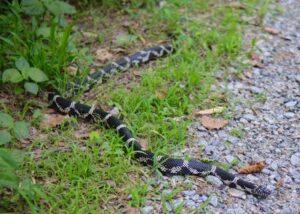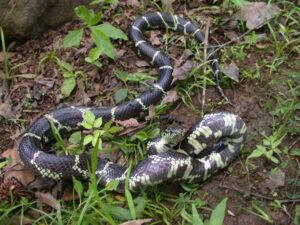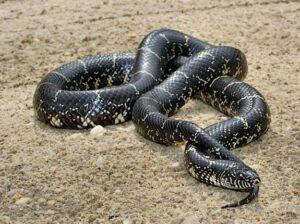The eastern kingsnake, common kingsnake or chain kingsnake is a smooth-scaled terrestrial snake that is mostly diurnal but can be nocturnal in the hottest months of the year. It is active from May to October in most parts of its range. The long and slender colubrid enjoys digging, basking, exploring, and hunting.
Scientific Classifications
- Suborder:Serpentes
- Family:Colubridae
- Genus:Lampropeltis
- Species:L. getula
Conservation Status
Subspecies
This snake has seven recognized subspecies.
- Brooks’ kingsnake (Lampropeltis getula brooksi)
- Florida kingsnake (Lampropeltis getula floridana)
- Eastern kingsnake (Lampropeltis getula getula)
- Speckled kingsnake (Lampropeltis getula holbrooki)
- Black kingsnake (Lampropeltis getula nigra)
- Mexican black kingsnake (Lampropeltis getula nigrita)
- Apalachicola Lowlands kingsnake (Lampropeltis getula meansi)
Description
Size
The snout-to-vent length of a full-grown common kingsnake is in the range of 36-42 inches (91.5-107 cm). The weight can vary between 10.1 oz (285 g) in a small individual and 80 oz (2268 g) in a big one.
Color and Appearance
The shiny black, blue-black, or dark brown colubrid has yellow or white chain-link bands that cross its back and connect along the sides of its body. This is why it is also known by the name chain kingsnake. The bands are wider for the snakes from the coastal plains, and they are thinner or completely absent in the ones from the mountainous regions. The head is short and stout with tiny beady eyes. The anal plate is not divided.
Are They Dangerous to Humans
If threatened, the snake can rattle its tail, spray musk and display quick, jerky movements to defend itself. But being non-venomous, it poses no danger to humans or pets. The secretive colubrid can be tamed easily with proper care and regular handling. It is very docile as a pet.
Eastern Kingsnakes at a Glance
Distribution
The snake is found in the United States in Arizona, Alabama, California, Arkansas, Colorado, Florida, Delaware, Georgia, south and southwest Illinois, southern Iowa, southern Indiana, Kentucky, Kansas, Louisiana, Nebraska, Maryland, Mississippi, Missouri, southern and western Nevada, New Jersey, New York, New Mexico, North Carolina, Oklahoma, southern Ohio, South Carolina, southern Oregon, Texas, southern Utah, Tennessee, Virginia, and West Virginia. It also lives in northern Mexico, including all of Baja California. The species has been introduced to Gran Canaria in the Canary Islands.
Habitat
The common kingsnake prefers open areas, particularly grasslands. But it can also be found in chaparral, oak woodlands, deserts, abandoned farms, sand, low mountains, and any riparian zone, like canals, swamps, and streams. They favor sites with dense shrubbery and thick layers of leaf litter.
The territorial males of the species engage in combat if their territory is threatened.
Lifespan
The eastern kingsnake lives for 25 years or even more.
Predators
Badgers, raccoons, roadrunners, hawks, and other snakes prey on it.
Diet
It eats other snakes, including venomous ones like copperheads, rattlesnakes, and coral snakes. The non-venomous snakes taken by it are common watersnakes, common garter snakes, smooth-earth snakes, ring-necked snakes, and worm snakes. Bird and turtle eggs, amphibians, northern bobwhite, small mammals (like white-footed mice), and lizards are also its food.
It kills them by constriction, avoiding being bitten by clamping down the jaws of its venomous prey. But even if envenomated, it is immune to the poison.
Reproduction
Oviparous (lays eggs that hatch outside the body)
The females lay up to several dozens of eggs that hatch after 2-2.5 months of incubation. The brightly colored hatchlings eat lizards, small snakes, and rodents. The species displays a neck-biting behavior when it breeds in spring.
Care Sheet
Size of the Enclosure: The size of the enclosure needs to increase with the length of the growing snake. Juveniles need 10-gallon vivariums. When they reach 24 inches, they need to be shifted to 20-gallon ones. For adult snakes attaining more than 4ft size, the enclosure size should be 40 gallons.
Temperature: The temperatures of the hot and cool sides should be 90OF and 75OF, respectively. The basking spot temperature should be no higher than 90OF.
Humidity: It prefers humidity levels of 35-45%. But it can be raised to 60% during shed cycles. A shallow water dish big enough for the snake to curl up and soak in should be provided in the cage.
Substrate: Aspen, bark chips, coconut fiber, and topsoil without perlite make ideal substrates. It should have a minimum thickness of 2 inches.
Feeding: It readily accepts live or frozen and thawed rodents as food. The babies can be fed every 7-10 days, while the feeding frequency is 10-14 days for an adult.
Source
inaturalist.ca, azreptiles.com, marylandbiodiversity.com, pr.brightspotcdn.com, virginiaherpetologicalsociety.com, reddit.com, madison.com, conservewildlifenj.org

